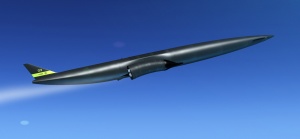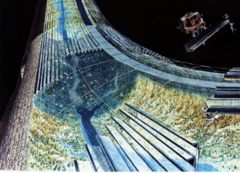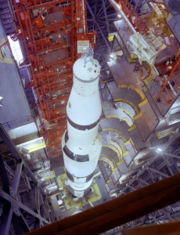Colonising Space
|
Some people wonder what is the point of heading off into space when we have a wonderful planet to live on that provides all of our needs, and rather usefully has an atmosphere that we can breathe...
One reason is survival. At the moment we have all our eggs in one basket here on Earth. If nothing else, space colonization will be an insurance policy that will allow life to survive on other spaceships should something catastrophic happen to Spaceship Earth. It is also the next great step for life inhabiting a new environment and spreading itself ever wider - something it has been doing for the past 3.7 billion years. Freed from scarcity, Man tends to look for interesting challenges and ways to extend his horizons. What greater adventure could there be than extending life beyond our home planet and reaching out into the stars? On a more pragmatic note, the resources in space of energy, material and living space are effectively unlimited. This will allow our civilisation to constantly expand while taking the burden off the Earth. Just as the New World held the promise of abundant gold and land to settlers of the Americas, space is a frontier filled with unfathomable wealth of all kinds. Simultaneously, it holds the best promise to help ensure our survival, and the most interesting way to extend our reach. It should be a top priority.
Resources within the solar system are mind-blowingly huge both in terms of energy and matter. There are planets, many moons and uncountable asteroids and comets. In space the sun is always shining and there is no atmosphere to attenuates it glare. Solar power is the obvious way to go in, at least in the inner solar system. Either photo-voltaic for electrical power or solar furnaces for material processing. Creating habitable places for people to live in this ultimately harsh environment is a matter of engineering – see advanced automation. Creating large space habitats requires the kind of technology described in the section on advanced automation.
There are many places that we could locate these habitats, especially near Earth. 
Accessing space has been a difficult business – it is expensive and if everything is not exactly right, catastrophic failure results. The only likely way to overcome these issues and make space accessible to a wide number of people is to make it completely open and collaborative. The plans, designs and processes need to be totally transparent, and anyone with the necessary expertise, motivation and imagination should have the opportunity to contribute. These people will be the force to actually make it happen.
Making the colonisation of space a truly global collaborative process is an amazing opportunity to bring people and cultures together. Not a project of any one nation but a project of humanity with contributions from everywhere. The culture of openness is also the perfect way to start the spread of life away from Earth - it is the right attitude and the best way for people to get the most out of each other. When people want to convey what we can accomplish as a species, the standard symbol is the Apollo moon landings; there is no field like space exploration for people to come together, co-operate and accomplish amazing things. Space exploration under the auspices of governments has proven too inefficient and expensive. Under government control, the cost of launch has been $5-15k per kilogram. This cost does not come from materials, or fuel, or anything else inherent in the technology; it comes from the inefficiency and expense of a development pipeline that requires every part to be built and inspected by hand. Spaceflight done by a commercial organisation is 4-10 times cheaper than an equivalent government-funded mission[1]. But open hardware is often 4-20 times cheaper than commercial equivalents. If open collaboration could achieve the same radical reduction in the cost of rockets that it has in 3D printing, electroencephalography, DNA sequencing and other areas, space would become accessible to all and it would mark the beginning of humanity's era as a spacefaring race. Commercial reasons alone are not the right basis for colonising space and the lesser efficiency of that model over an open culture would likely only ever make it a niche activity with potential for conflict. It is due to the lack of commercial viability that no-one has left low-earth orbit since the Apollo program. But open culture does not need to revolve around conventional economics. There have been fewer than 500 manned spaceflights in human history, largely because of the prohibitive cost. Radically cheaper spaceflight will allow us to fly thousands of spaceflights a year. This is the only way to accrue the knowledge needed to make launches reliable. Ultimately the possibility of space colonisation is a matter of energy, material, information and intelligence — and all four are in reality massively abundant. We now have access to space using rockets although this is still expensive (over $5000 per pound of material launched[2]) and the failure rate is quite high. This severely limits what we can do in space; it is the main obstacle to space solar power and the colonisation of space. So far, we have only dipped our toes, if we want to really dive in we have to make spaceflight cheap and reliable. It may be that using abundant solar energy and seawater and advanced automation, mature rocket technologies like liquid-fuelled rockets actually end up becoming cheap and common-place, perhaps in conjunction with solid-rocket boosters like the Space Shuttle uses that employ metal fuels and inorganic oxidizers made from common elements.  Skylon single-stage-to-orbit (SSTO) hybrid air-breathing/rocket space-plane designed to carry 40 tonnes of cargo or 40 passengers to low earth orbit However many alternative and interesting launch systems are thought to be technically (or at least theoretically) feasible ranging from single stage to orbit hybrid air-breathing/rocket space-planes (SSTOs), electromagnetic and balloon platform launch assist to more exotic space fountains, launch loops and geosynchronous space elevators. It may be that launch strategies that can have their power systems decoupled from the propellant/propulsion systems and installed on the ground may end up being more economical and efficient in terms of energy expended per unit weight lofted into space. Information on these alternative launch methods are covered in more detail in this WP article General space advocacy organisations
Open-source space organisations and projects
Other
|
 [print version]
[print version]  [update]
[update]  [site map]
[site map]Detailed tour:  previous page | next page
previous page | next page 





